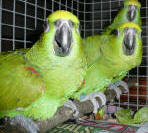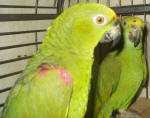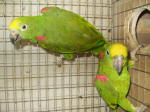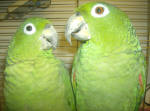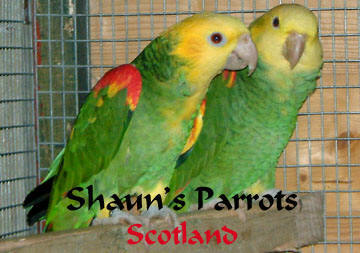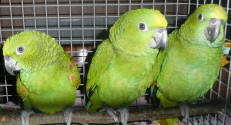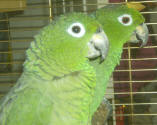How to tell the difference between a Blue-Front and an Orange-Wing?
There are a few differences but the most obvious is the colour of the beak - the Blue-Front has a black beak
whereas the Orange-Wing's beak is "horn-coloured" (often with darker streaks).
Hand-reared Orange-Wings can make just as affectionate and sometimes a better pet bird than the Blue-Front. Average length of an AMAZON 32 cm (approx 12
Especially the nominate Blue-Front (Amazona aestiva aestiva).
The Blue fronts are often better talkers than the Orange-Wings but be aware that when nearing sexual maturity
(esp. as a breeding bird) the nominate Blue-Front is often EXTREMELY AGGRESSIVE.
The Cuban Amazons and the White-Fronted are both a medium-sized Parrot, yet are classed amongst the smallest of the Amazon Parrots.
FEEDING
-
Amazons will eat a good Parakeet Mix - Not too many large Sunflower seeds - smaller sunflower seeds are preferable but still feed in limited quantities, as they are fattening and addictive.
-
A "PARROT" Mix will normally have too many sunflower seeds and just be too fattening for an Amazon.
-
A lot of seed manufacturers now have formulated mixes specifically for different Breeds dietary Needs!
-
Low fat diets specially formulated for Amazons are available. I personally like the Verselle Laga mixes.
-
Amazons can easily become overweight and unhealthy if fed too many fattening seeds. (i.e. sunflower, hemp, linseed, pulses such as "micronised" (flattened/dried) peas and maize.
-
In winter extra Sunflower seeds and hemp can be added but only in small quantities - to help keep them warm.
-
They enjoy a variety of seeds.
They love all the Fruit and Veg., which should make up approx 30% of their diets.
(i.e. carrot, apple, celery, broccoli, pomegranate, orange, grapes, papaya, guava, passion fruit, pineapple and banana. Corn-on-the-cob, beetroot, Pea-pods, mange-tout, sugar-snap peas, green beans and courgettes are favourites. Plus cooked, frozen peas and sweet corn.
In the wild the Amazon parrots eats a variety of seeds, nuts, fruits, berries and vegetation.
They clamber from branch to branch while feeding instead of flying.
They love the fruits of the oil palm.
Wild Amazons have limited access to tree and plant seeds but there would be a greater variety of seed types to chose from as different plants come into season.
Commercial "All-seed mixes" tend to be high in fat and provide a limited or imbalanced source of many essential nutrients necessary for good health.
This could lead to health problems and potentially shorten the life of your Amazon and certainly wouldn't help your breeding results!Amazons are vulnerable to calcium and vitamin A deficiencies (similar to an African Grey).
So, you would need to try and make sure that they had a diet with sufficient calcium and Vit. A in it.
Be very careful though cos you can overdose Vit A as any excess is stored in the Liver as it's a "fat soluble vitamin" Raw Carrots contain Vit. A.
Also, be wary of offering calcium supplements at breeding time prior to the hen laying, (especially when mixing with their water or soft foods - as then they ingest it whether they want it or not - and you can't regulate the quantities, as it totally depends on how much the bird eats of drinks whatever the calcium has been mixed in.)
If you do decide to use a Calcium supplement prior to breeding - make sure you follow the quantities recommended, to the letter, to prevent potential problems.
Also, if you get the quantities wrong then the eggshell or inner membranes may be too tough for the chicks to break thru and you then don't get a successful hatch!! and that is a shameful waste esp. if the chick has reached full-term and is "ready to hatch" but just can't get out!I personally prefer to make sure the diet is good leading up to breeding and then offer Calcium supplements once the hen has laid - this then replenishes calcium used to form the egg shells. Rather than risking over-dosing prior to the eggs being formed and possibly losing fully-formed chicks due to the shells being too "Strong".
Calcium important for Blue Fronted Amazons
Amazons are also prone to obesity, similar to a Galah (Roseate cockatoo).
All these factors must be taken into consideration when caring for your Amazon, be it a Pet Bird or a Breeding Bird to ensure optimum health and fitness.
DIET for BREEDING
In preparation for the breeding season you must "up" their Protein levels
Start doing this gradually at least 3 - 4 weeks prior to their Breeding season.
To do this you can add the following to the birds' staple diet to help bring it into breeding condition:
Foods high in protein are essential and help to stimulate breeding condition.
Cooked strips of Chicken (on the bone is enjoyed too). Aldi sell cooked, frozen chicken strips £1:99 (2010)
Small cubes of cheese (can be grated onto soft foods) can also be offered in moderation
Cheese offers a source of protein and calcium but beware it is also high in fat.
Birds, in general, are lactose intolerant, so milk products should be fed in moderation to prevent
digestive upsets.
Live Natural Yoghurt can be mixed into soft foods - this also provides Milk proteins + calcium and has
pro-biotic properties which help the digestive system, especially good when introducing lots of new
high protein foods that require different "Gut Microbes" to aid digestion.
Feed in moderation, as per cheese, because of the birds natural intolerance to Lactose content.
A good rearing food can be made by using - Egg Food (you can get moist variety now - I like Rob Harvey's) add finely shredded orange, sliced grapes, mashed banana,(+ any other fruits) mixed together.
Cooked pulses (beans, lentils, etc) are also very useful and nutritious.
AVIARY-LIFE
-
They do need a spacious Aviary, esp. during breeding time, as males can be extremely aggressive toward females in many species. Not for the beginner
- 10ft+ long x 8ft wide minimum as they need plenty of space to fly and give the hen space to evade the cockbird.
One pair per Aviary esp. during breeding time - double meshing (2" min) essential between adjoining Aviaries
Be aware of where you position your Nest box - quiet, dark corners are preferred with screening from "prying eyes" in adjoining Aviaries.
Place a big piece of plywood in place to give necessary screening.-
they like branches of all shapes and size to help keep the muscles in their feet exercised
-
The branches don't have to be horizontal - after all you don't find all the branches on a tree on a horizontal plane - so make sure the bird has a good selection.
-
Make sure they also have very wide perches 3"+ as well as thinner ones.
-
Plenty with bark still on off safe trees, for them to chew
- keeps their beaks trim and keeps them occupied and happy!
-
MATING
It is possible for a Cock-bird can fertilise a full clutch of eggs in one mating - as long as the mating takes place b4 the albumin (white) part of the egg has been formed within the hen.
This is why sometimes the first egg is infertile - the mating has taken place after the formation of the albumen.
POTENTIAL PROBLEMS
Health: Tendency toward obesity and related health issues.
Also, a clean, non-stuffy atmosphere with plenty of fresh air but no Draughts is essential to help prevent upper respiratory infections (Vit A is very useful to help prevent respiratory problems - this is found in Carrots)
SEXING AMAZONS
Juvenile Amazons:
Young Amazon parrots have a dirty gray brown iris.
This will change within 2 to 3 years to a red, red-orange, or chestnut-brown.
At that point, it is very difficult to determine the age of an Amazon.
'Dimorphic' Types:
Dimorphic means having some visual characteristics that may aid in determining sex.
Though the sex cannot be reliably determined by physical characteristics of most of the Amazons, there are two species two species that are dimorphic.
They are the Yellow-lored Amazon - Amazona xantholora (rarely seen in the Bird trade)
and the White-fronted Amazon - Amazona albinfrons.
'Monomorphic' Types:
Monomorphic means having no definite differences that can be seen.
The sex on all others Amazon parrots than the two listed above must be determined by either a surgical probe, endoscopy, which can be done by many veterinarians or by a DNA testing, usually a blood sample or a few plucked feathers sent to be diagnosed in a lab.
Breeding Age depends on the species, but generally at 3-5 years of age.
Springtime is the most obvious period to watch for this.
It is best to train amazons to stand on your hand and NOT on your shoulder because of their unpredictability during "mating season."
It is important to learn to recognize their moods and not to attempt to pick up an Amazon when its eyes are flashing and the tail is flared!
BREEDING
-
Nest boxes are best if the are approx. 2ft deep x 12" square.
See Notes on Nest boxes for info. on bedding and pop-holes etc.,
Make sure you do NOT position facing South - the sun will make it unbearably hot during the summer months. You are much better facing away from the sun - they prefer shading at all times - it makes them feel secure.
-
Put a respectable covering of Easibed substrate into the bottom of the Nest box. Also bits of rotten (clean) wood or soft untreated plywood chunks for them to chew.
Chewing the wood stimulates them into breeding condition. -
As per most breeds they need extra Protein when breeding and feeding chicks.
IN THE WILD :
During the day the male remains close to the nest, but at dusk he flies off to the communal roost.
The Hen leaves the nest for short periods when the male comes to feed her.
-
The Hen lays 2 - 4 eggs (more usually 2)
-
incubation period of approx. 26 - 29 days.
Who Broods: Only the female broods. -
Chicks start to fledge around 40 - 60? days.
Independence: a further 3 weeks after fledging -
Ring: 14 - 16 days Ring size: U (same as the Galah)
-
An eye should be kept on the male once the chicks fledge, to be certain the male does not become
prematurely aggressive and harm the young in his desire to start a new nest.
-
Fledglings must also be watched carefully because their initial attempts to fly can produce un-co-ordinated movements that can result in injury.
-
For this reason, it is important not to startle the young birds.
-
This period of clumsiness generally does not last long, however, and young birds become proficient flyers after only a few days of effort.
-
